英语学科教育学
- 格式:ppt
- 大小:204.50 KB
- 文档页数:32
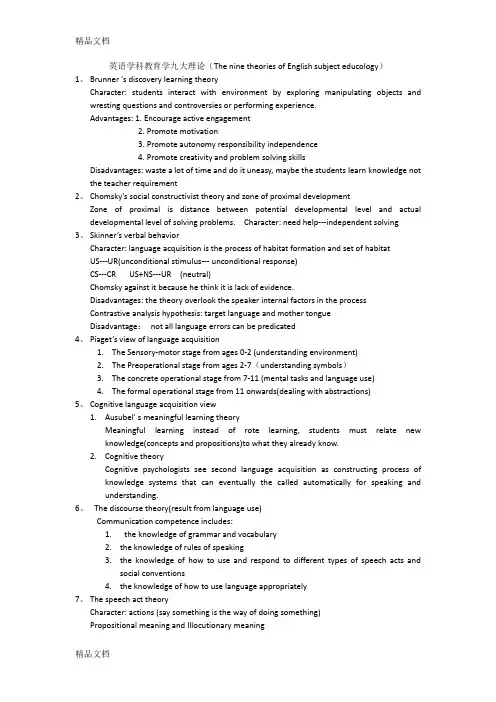
英语学科教育学九大理论(The nine theories of English subject educology)1、Brunner ‘s discovery learning theoryCharacter: students interact with environment by exploring manipulating objects and wresting questions and controversies or performing experience.Advantages: 1. Encourage active engagement2. Promote motivation3. Promote autonomy responsibility independence4. Promote creativity and problem solving skillsDisadvantages: waste a lot of time and do it uneasy, maybe the students learn knowledge not the teacher requirement2、Chomsky’s social constructivist theory and zone of proximal developmentZone of proximal is distance between potential developmental level and actual developmental level of solving problems. Character: need help---independent solving3、Skinner’s verbal behaviorCharacter: language acquisition is the process of habitat formation and set of habitatUS---UR(unconditional stimulus--- unconditional response)CS---CR US+NS---UR (neutral)Chomsky against it because he think it is lack of evidence.Disadvantages: the theory overlook the speaker internal factors in the processContrastive analysis hypothesis: target language and mother tongueDisadvantage:not all language errors can be predicated4、Piaget’s view of language acquisition1.The Sensory-motor stage from ages 0-2 (understanding environment)2.The Preoperational stage from ages 2-7(understanding symbols)3.The concrete operational stage from 7-11 (mental tasks and language use)4.The formal operational stage from 11 onwards(dealing with abstractions)5、Cognitive language acquisition view1.Ausubel’ s meaningful learning theoryMeaningful learning instead of rote learning, students must relate new knowledge(concepts and propositions)to what they already know.2.Cognitive theoryCognitive psychologists see second language acquisition as constructing process of knowledge systems that can eventually the called automatically for speaking and understanding.6、The discourse theory(result from language use)Communication competence includes:1.the knowledge of grammar and vocabulary2.the knowledge of rules of speaking3.the knowledge of how to use and respond to different types of speech acts andsocial conventions4.the knowledge of how to use language appropriately7、The speech act theoryCharacter: actions (say something is the way of doing something)Propositional meaning and Illocutionary meaningLocutionary act: say something with a certain meaning in traditional sense……Illocutionary act: convincing persuading deterring……1.Assertives2.directivesmissives4.expressives5.declaratives8、The universal grammarPositive evidence and Negative evidenceDirect access: language acquisition devicesIndirect accessPartial accessNo accessDisadvantages: 1. UG proponents have to deal with acquisition to account for the language itself 2. Chomsky only learned the core language not learn peripheral grammarmunication is discarded 4. Methodological9、10、The monitor model hypothesis1.2.The acquisition-learning theory(acquisition is subconscious and learning is conscious)3.The natural order hypothesis4.The input hypothesis(The understanding input; The relevant input; no grammaticallysequenced)5.6.The monitor hypothesis(1.there must be enough time 2. Focus is on forms not meaning 3.The learner must know the rule)7.The affective filter hypothesis。
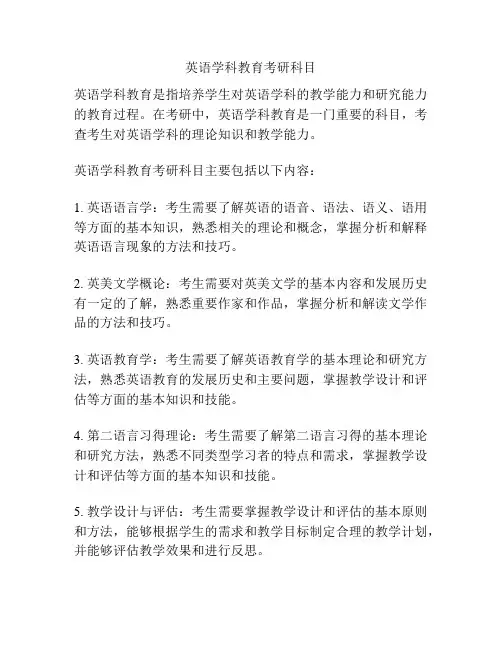
英语学科教育考研科目
英语学科教育是指培养学生对英语学科的教学能力和研究能力的教育过程。
在考研中,英语学科教育是一门重要的科目,考查考生对英语学科的理论知识和教学能力。
英语学科教育考研科目主要包括以下内容:
1. 英语语言学:考生需要了解英语的语音、语法、语义、语用等方面的基本知识,熟悉相关的理论和概念,掌握分析和解释英语语言现象的方法和技巧。
2. 英美文学概论:考生需要对英美文学的基本内容和发展历史有一定的了解,熟悉重要作家和作品,掌握分析和解读文学作品的方法和技巧。
3. 英语教育学:考生需要了解英语教育学的基本理论和研究方法,熟悉英语教育的发展历史和主要问题,掌握教学设计和评估等方面的基本知识和技能。
4. 第二语言习得理论:考生需要了解第二语言习得的基本理论和研究方法,熟悉不同类型学习者的特点和需求,掌握教学设计和评估等方面的基本知识和技能。
5. 教学设计与评估:考生需要掌握教学设计和评估的基本原则和方法,能够根据学生的需求和教学目标制定合理的教学计划,并能够评估教学效果和进行反思。
6. 教学实践:考生需要具备一定的教学实践经验,能够进行教学实验和教学观察,熟悉课堂管理和教学技巧。
考研英语学科教育科目主要考查考生的英语语言能力、英语学科理论知识和教学能力。
考生需通过深入学习和实践,掌握相关知识和技能,为将来从事英语学科教育工作做好准备。

目录摘要 (i)Abstract (ii)1、引言 (1)2、普遍存在的问题 (1)2.1英语教育学课程科目少且时间短 (1)2.2英语教育观念陈旧且方式落后 (2)2.3未能充分利用多媒体设施教学 (2)3、解决的方法 (2)3.1切实转变英语教育教学方法 (2)3.2充分利用多谋体等现代科技工具 (3)4、结束语 (3)参考文献 (4)摘要:目前,许多高校不太重视英语教育学的发展,绝大多数的英语教师获得的本科及以上学位不是“英语教育”,而是“外国语言学及应用语言学”、“外国文学”、“英语语言学”或其他专业的学位,对英语教育学错误的认识严重影响了英语教师教育的专业化发展。
为此,笔者首先在引言部分阐述了英语教育学的定义及其分类,然后指出了英语教育中普遍存在的问题以及提出了一些解决的措施。
关键词:英语教育学,英语教育,英语专业Abstract:At present, a number of universities pay less attention to the development of English educology. A majority of English teacher acquire the academic degree called Foreign Linguistics, Applied Linguistics, Foreign Literature and English Linguistics rather than English Education. Therefore, the wrong cognization of English Educology seriously influence the major development of English teachers. For this purpose, the writer states the definition and classification of English Educology in the introduction.Then, the writer points out some common questions in English education and puts forward some effective measures.Key words:English Educology, English Language Teaching, English major1、引言所谓英语教育学,就是旨在研究英语教学过程中的现象,问题和规律的科学。

英语学科教学方向课程一、引言随着全球化时代的到来,英语在国际交流中扮演着举足轻重的角色。
在我国,英语作为一门重要的学科,其教学质量和水平直接关系到国家人才培养的整体水平。
为此,英语学科教学方向课程应运而生,旨在培养具有专业素养和教学能力的英语教师。
本文将从英语学科教学的重要性、课程设置背景、核心内容、学习方法、发展趋势、社会价值等方面展开论述,以期为广大英语教育工作者提供有益的参考。
二、英语学科教学方向课程的核心内容英语学科教学方向课程围绕英语语言知识与技能、英语教学方法与策略、英语学科教育心理学、英语课程设计与评价等核心内容展开。
其中:1.英语语言知识与技能:课程将帮助学生系统地学习英语语言知识,包括语音、语法、词汇、听力、口语、阅读和写作等方面,以提高其语言应用能力。
2.英语教学方法与策略:课程将向学生传授各种教学方法和策略,如启发式教学、任务型教学、合作学习等,使学生能够根据不同的教学场景和学生的特点灵活运用。
3.英语学科教育心理学:课程将引导学生学习英语教育心理学的基本原理,以便更好地了解学生的认知发展规律,激发学习兴趣,提高教学效果。
4.英语课程设计与评价:课程将教授如何进行英语课程设计,包括设定教学目标、编制教学计划、选择教学资源等,以及如何进行教学评价,如形成性评价、终结性评价等。
三、英语学科教学方向课程的学习方法为了提高课程质量,英语学科教学方向课程采用多种学习方法,包括:1.课堂参与与讨论:鼓励学生积极参与课堂讨论,分享教学经验和心得,提高思考和表达能力。
2.案例分析与实践:课程将提供丰富的教学案例,让学生学会分析问题、解决问题,提高实际教学能力。
3.教学模拟与反思:学生可通过教学模拟实习,检验所学知识和技能,并在反思中不断成长。
4.学术研究与写作:课程将教授学术研究方法和论文写作技巧,培养学生的学术素养和创新能力。
四、英语学科教学方向课程的发展趋势随着教育信息化的推进,英语学科教学方向课程呈现出以下发展趋势:1.融合信息技术的教育创新:利用现代信息技术,如网络、多媒体等,丰富教学手段和资源,提高教学质量。
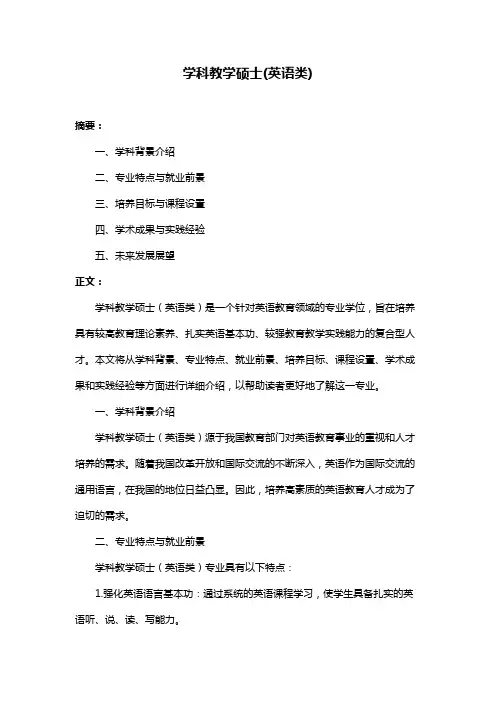
学科教学硕士(英语类)摘要:一、学科背景介绍二、专业特点与就业前景三、培养目标与课程设置四、学术成果与实践经验五、未来发展展望正文:学科教学硕士(英语类)是一个针对英语教育领域的专业学位,旨在培养具有较高教育理论素养、扎实英语基本功、较强教育教学实践能力的复合型人才。
本文将从学科背景、专业特点、就业前景、培养目标、课程设置、学术成果和实践经验等方面进行详细介绍,以帮助读者更好地了解这一专业。
一、学科背景介绍学科教学硕士(英语类)源于我国教育部门对英语教育事业的重视和人才培养的需求。
随着我国改革开放和国际交流的不断深入,英语作为国际交流的通用语言,在我国的地位日益凸显。
因此,培养高素质的英语教育人才成为了迫切的需求。
二、专业特点与就业前景学科教学硕士(英语类)专业具有以下特点:1.强化英语语言基本功:通过系统的英语课程学习,使学生具备扎实的英语听、说、读、写能力。
2.丰富教育理论知识:学习教育心理学、教育管理学等课程,提升学生的教育理论素养。
3.注重实践操作能力:通过实习、实训等环节,使学生具备较强的教育教学实践能力。
4.培养创新意识:鼓励学生开展教育教学研究,培养其创新意识和教育教学改革能力。
就业前景方面,学科教学硕士(英语类)毕业生可在中小学、高校、职业技术学校等教育机构担任英语教师;也可在教育行政机构、教育培训机构、翻译公司等企事业单位从事与英语教育相关的工作。
三、培养目标与课程设置学科教学硕士(英语类)的培养目标是为我国英语教育事业输送具有硕士学历、高素质的英语教师。
课程设置方面,既包括英语专业课程,如英语语法、英语阅读、英语写作等,也包括教育类课程,如教育学、教育心理学等。
此外,还设有实践类课程,如教育实习、教育调查等,以培养学生的实践操作能力。
四、学术成果与实践经验学科教学硕士(英语类)专业学生在学术研究方面取得了一系列成果,如发表论文、编写教材等。
在实践经验方面,学生通过实习、实训等环节,积累了丰富的教育教学经验,为今后从事英语教育工作奠定了基础。
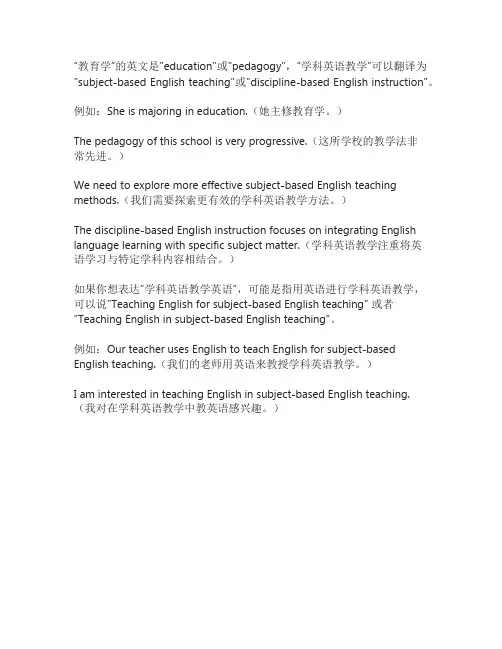
“教育学”的英文是"education"或"pedagogy",“学科英语教学”可以翻译为"subject-based English teaching"或"discipline-based English instruction"。
例如:She is majoring in education.(她主修教育学。
)The pedagogy of this school is very progressive.(这所学校的教学法非常先进。
)We need to explore more effective subject-based English teaching methods.(我们需要探索更有效的学科英语教学方法。
)The discipline-based English instruction focuses on integrating English language learning with specific subject matter.(学科英语教学注重将英语学习与特定学科内容相结合。
)如果你想表达“学科英语教学英语”,可能是指用英语进行学科英语教学,可以说"Teaching English for subject-based English teaching" 或者"Teaching English in subject-based English teaching"。
例如:Our teacher uses English to teach English for subject-based English teaching.(我们的老师用英语来教授学科英语教学。
)I am interested in teaching English in subject-based English teaching.(我对在学科英语教学中教英语感兴趣。
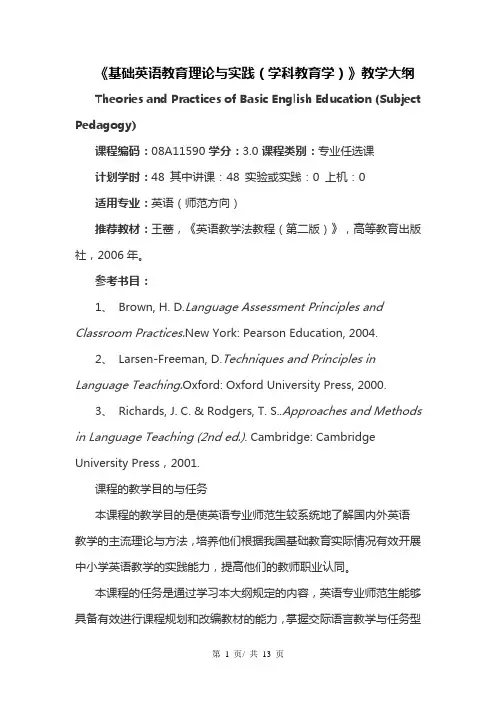
《基础英语教育理论与实践(学科教育学)》教学大纲Theories and Practices of Basic English Education (Subject Pedagogy)课程编码:08A11590 学分:3.0 课程类别:专业任选课计划学时:48 其中讲课:48 实验或实践:0 上机:0适用专业:英语(师范方向)推荐教材:王蔷,《英语教学法教程(第二版)》,高等教育出版社,2006年。
参考书目:1、Brown, H. nguage Assessment Principles and Classroom Practices.New York: Pearson Education, 2004.2、Larsen-Freeman, D.Techniques and Principles in Language Teaching.Oxford: Oxford University Press, 2000.3、Richards, J. C. & Rodgers, T. S..Approaches and Methods in Language Teaching (2nd ed.). Cambridge: Cambridge University Press,2001.课程的教学目的与任务本课程的教学目的是使英语专业师范生较系统地了解国内外英语教学的主流理论与方法,培养他们根据我国基础教育实际情况有效开展中小学英语教学的实践能力,提高他们的教师职业认同。
本课程的任务是通过学习本大纲规定的内容,英语专业师范生能够具备有效进行课程规划和改编教材的能力,掌握交际语言教学与任务型语言教学的基本观点和教学方法,能够理论联系实际,将形成性评估和终结性评估相结合,有效组织课堂活动和任务,从而为其毕业后从事基础英语教育打下基础。
课程的基本要求1、要求学生具有分析《国家英语课程标准》、制订课程规划和改编教材的能力,为有效组织教学活动做好充分准备。
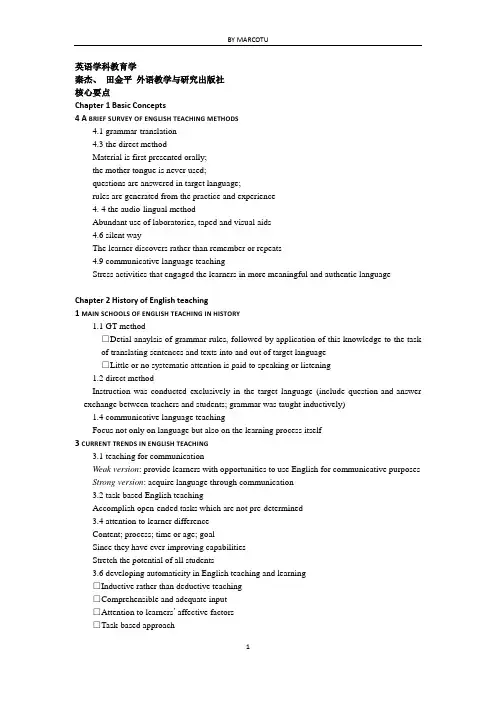
英语学科教育学秦杰、田金平外语教学与研究出版社核心要点Chapter 1 Basic Concepts4A BRIEF SURVEY OF ENGLISH TEACHING METHODS4.1 grammar-translation4.3 the direct methodMaterial is first presented orally;the mother tongue is never used;questions are answered in target language;rules are generated from the practice and experience4. 4 the audio-lingual methodAbundant use of laboratories, taped and visual aids4.6 silent wayThe learner discovers rather than remember or repeats4.9 communicative language teachingStress activities that engaged the learners in more meaningful and authentic languageChapter 2 History of English teaching1 MAIN SCHOOLS OF ENGLISH TEACHING IN HISTORY1.1 GT method□Detial anaylsis of grammar rules, followed by application of this knowledge to the task of translating sentences and texts into and out of target language□Little or no systematic attention is paid to speaking or listening1.2 direct methodInstruction was conducted exclusively in the target language (include question-and-answer exchange between teachers and students; grammar was taught inductively)1.4 communicative language teachingFocus not only on language but also on the learning process itself3 CURRENT TRENDS IN ENGLISH TEACHING3.1 teaching for communicationWeak version: provide learners with opportunities to use English for communicative purposes Strong version: acquire language through communication3.2 task-based English teachingAccomplish open-ended tasks which are not pre-determined3.4 attention to learner differenceContent; process; time or age; goalSince they have ever improving capabilitiesStretch the potential of all students3.6 developing automaticity in English teaching and learning□Inductive rather than deductive teaching□Comprehensible and adequate input□Attention to learners’ affective factors□Task-based approach□Strategic training4 A STUDY IB TASK-BASED LANGUAGE TEACHING4.1 introductionTraditional way: master the building blocks of the language; teacher presents the target language in ready-to assimilate piecesBy contrast: errors are not necessarily the result of bad learningEngage in meaningful activities such as problem-solving, role playing, discussion4.2.3 the feature of TBLTObjective-oriented;discover rules of grammar;focus on meaning rather than form;bear resemblance to activities people carry out in daily life4.3 advantage of TBLTTeaching is not the controller and sole knowledge source; create the kind of atmosphere which enhance participation; stimulate curiosity, raise interest and encourage students to practiceChapter 4 Teaching of Different Language Skills1 LISTENING1.1introductionlistening skills: recognize stress and rhythm patterns; guess unknown words or phrases; detect key words; predict what people are going to talk, etc1.2process1.2.1 three stages of listeningPre-listening:Strategies: build necessary background to set purpose for listening (activate existing knowledge; build prior knowledge; establish purpose)During listening:While listening activities: clarify meaning; question; making predictionsTeacher’s help:elicit summary at each stop;ask for prediction and why students make particular predictions;review previous prediction and let them change their ideasinvolve everyone by letting them show hands or take sidesAfter listening:Activities:ask Q to clarify their understanding;summarize a speaker’s presentation orally, in writing;review notes and add informationTo sum up: give a clear lead in what they are going to hear; use visual backup for them to understand; give questions and tasks which help in learning, not confusing.1.3Methodism teaching of listeningdefault method: pick out a particular grammar point or some difficult words to explainintegrated method: use several skills within real context and communicative framework REFER TO PG 1042SPEAKING2.1introductionNot just involve putting into practice the grammar and vocabulary skill or just pronouncing and reading aloudInteractive: face to facePartial interactive: lectureNon interactive: watching TV2.3 how to teach speakingContented oriented input: focus on informationForm oriented input: focus on the ways of using the languageStructured output: focus in correct formCommunicative output: focus on the main purpose to complete a task2.3.2 3 key issues in speaking classesForm focuses speaking:□Repetition drill: teachers ask learners to repeat a phrase or sentenceMeaning focused speaking:□Presents some new vocabulary or grammatical features;□Before take part in an activity; ask learners to work in pairs or groups of 3 or 4 to prepare□Learners are given topics to talk(newspaper talks: instead of reading the article aloud, the learners must describe the main idea of the article given to the learners)2.4 developing speaking activitiesStructured output activities: information gap activitiesCommunicative output activities: role plays which imitate life; discussion3TEACHING OF READING3.1introductiona repetitive skill that helps build vocabulary3.1.1micro- & macro- skillsmicro-skills: deciphering the script; recognize vocabulary; figure out the meaning; makethe foregoing inference; predict outcomesmacro-skills: plan on the purpose to read; evaluate the reading speed; monitor thegeneral reading process etc3.1.1 goal of teaching reading□Maximize comprehension of text, identify relevant or non relevant information□Develop the awareness of reading process and reading strategies3.2three stages of readingBefore: set a purpose; know linguistic of background knowledgeDuring: verify predictions; decide what is important to understandAfter: decide the strategies used were appropriate; evaluate comprehension3.2.3 strategies for developing reading skills1) core reading strategiesPreview: get a sense of structure and contentPredict: use knowledge of subject matter, of the text type, about the authorSkimmer and scanning a quick survey of the textParaphrasing: restate the information and the ideas in the textBy encouraging students to talk about the strategies they think will help2) strategic reading for cognitionReading is an essential part of language instruction at every level3.3developing reading activities3.3.2 student preparationPre-reading activities:□Give students the background knowledge necessary for comprehension of the text or activating the existing knowledge□Make student aware of the type of the text□Provide opportunities for group or collaborative work and for class discussion activities□Use the title or subtitles to predict the content□Look at pictures, maps, diagrams or graphs4TEACHING OF WRITING4.1 introduction4.1.3 writing to learn VS writing to communicateGather facts and ideas together→a period of critical analysis→a draft paperPresent facts and inference in the most efficient manner4.2 key writing models4.2.1 introductionProduct model: focus on error correction and telling rather than showingProcess model: emphasize activities geared toward discovering things to say about a topic, drafting, pausing, sharing work in process, revising and editing4.2.2 product-oriented VS process-oriented writingproduct-oriented: correct and grade; feedback is limited to grammatical, structural or mechanical errorsprocess-oriented: engage students in classroom activities to stimulate their ideas; establish viewpoint purposefully (putting down ideas and get the first draft→get feedback from others→produce more draft until receive satisfactory comments→hand in their product and get a more sincere and effective evaluation from teachers)summary: a balance between process approach and product approach4.3 trend4.3.1 more focus on processRespond to the content more than the formHelp with error correction and give organizational adviceClassroom activities:Pre-writing: students are divided into groups to produce ideas about the topic; make a plan before they start; generate ideas about the topicFocusing on ideas: fast writing---write quickly on the topic for 5-10 min without worrying about language or punctuation; Group composition---work in groups, sharing ideas Evaluating, structuring and editing4.3.2 peer editing REFER TO PG1675 TEACHING OF GRAMMAR AND VOCABULARY5.1 introduction to the teaching of grammar5.1.1 various schools of grammarPrescriptive grammar; systematic functional grammar5.2 fundamentals of grammar teaching5.2.3 classroom grammar activitiesGrammar is taught in context, in discourse and in communication to maintain students’interest□Describe grammar point and give examples□Ask students to practice the grammar point in communication drill□Have communicative task that provide students opportunities to use grammar point5.2.4 textbook grammar activitiesMechanical drill: each prompt has only one correct response; complete the exercise without attendong to meaningMeaningful drill: each prompt has only one correct response; complete the exercise with attendong to meaningCommunicative drill: the prompt and qusetion is life-oriented, open-ended; students can have answers in line with their uinderstanding5.3 planning a grammar lessonDeductive approach and inductive approachTeacher-centered and learner-centeredPresentation: REFER TO PG187Practice: gap filling; substitution drills; sentence transformations; picture dictation; recording sentences and matching sentences to picturesProduction: information gap; role play; spot the difference between two pictures, problem solving5.4 teaching of vocabulary5.5 strategies and methods of vocabulary learning and teaching□Create mental linkages: grouping, association, place words into context□Apply images and sounds□Meaningful task□Recycling: one or two days after initial input□Diagram and word trees5.5.5 guessing from context5.5.7 definition plus collocation in vocabulary teaching and learning。
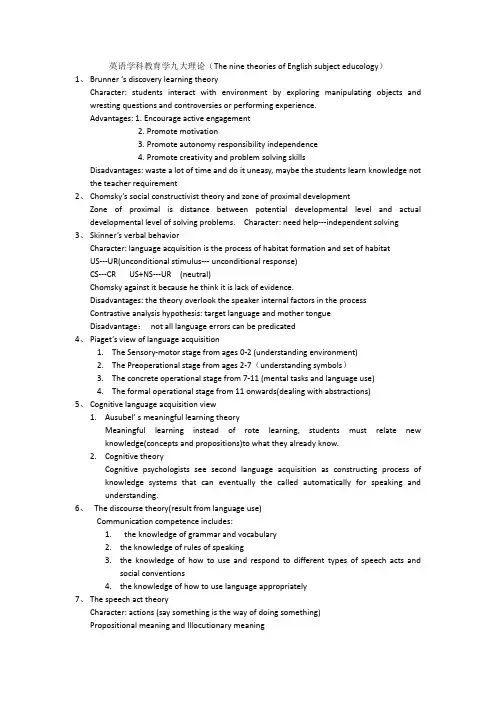
英语学科教育学九大理论(The nine theories of English subject educology)1、Brunner ‘s discovery learning theoryCharacter: students interact with environment by exploring manipulating objects and wresting questions and controversies or performing experience.Advantages: 1. Encourage active engagement2. Promote motivation3. Promote autonomy responsibility independence4. Promote creativity and problem solving skillsDisadvantages: waste a lot of time and do it uneasy, maybe the students learn knowledge not the teacher requirement2、Chomsky’s social constructivist theory and zone of proximal developmentZone of proximal is distance between potential developmental level and actual developmental level of solving problems. Character: need help---independent solving3、Skinner’s verbal behaviorCharacter: language acquisition is the process of habitat formation and set of habitatUS---UR(unconditional stimulus--- unconditional response)CS---CR US+NS---UR (neutral)Chomsky against it because he think it is lack of evidence.Disadvantages: the theory overlook the speaker internal factors in the processContrastive analysis hypothesis: target language and mother tongueDisadvantage:not all language errors can be predicated4、Piaget’s view of language acquisition1.The Sensory-motor stage from ages 0-2 (understanding environment)2.The Preoperational stage from ages 2-7(understanding symbols)3.The concrete operational stage from 7-11 (mental tasks and language use)4.The formal operational stage from 11 onwards(dealing with abstractions)5、Cognitive language acquisition view1.Ausubel’ s meaningful learning theoryMeaningful learning instead of rote learning, students must relate new knowledge(concepts and propositions)to what they already know.2.Cognitive theoryCognitive psychologists see second language acquisition as constructing process of knowledge systems that can eventually the called automatically for speaking and understanding.6、The discourse theory(result from language use)Communication competence includes:1.the knowledge of grammar and vocabulary2.the knowledge of rules of speaking3.the knowledge of how to use and respond to different types of speech acts andsocial conventions4.the knowledge of how to use language appropriately7、The speech act theoryCharacter: actions (say something is the way of doing something)Propositional meaning and Illocutionary meaningLocutionary act: say something with a certain meaning in traditional sense……Illocutionary act: convincing persuading deterring……1.Assertives2.directivesmissives4.expressives5.declaratives8、The universal grammarPositive evidence and Negative evidenceDirect access: language acquisition devicesIndirect accessPartial accessNo accessDisadvantages: 1. UG proponents have to deal with acquisition to account for the language itself 2. Chomsky only learned the core language not learn peripheral grammarmunication is discarded 4. Methodological9、The monitor model hypothesis1.The acquisition-learning theory(acquisition is subconscious and learning is conscious)2.The natural order hypothesis3.The input hypothesis(The understanding input; The relevant input; no grammaticallysequenced)4.The monitor hypothesis(1.there must be enough time 2. Focus is on forms not meaning 3.The learner must know the rule)5.The affective filter hypothesis。
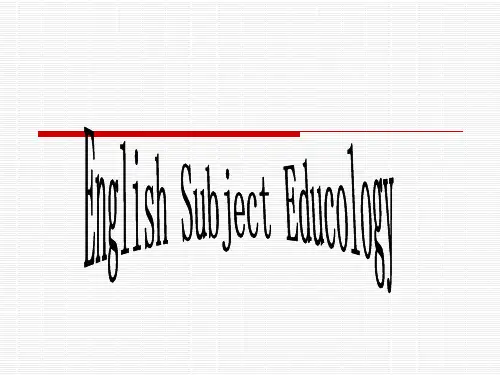
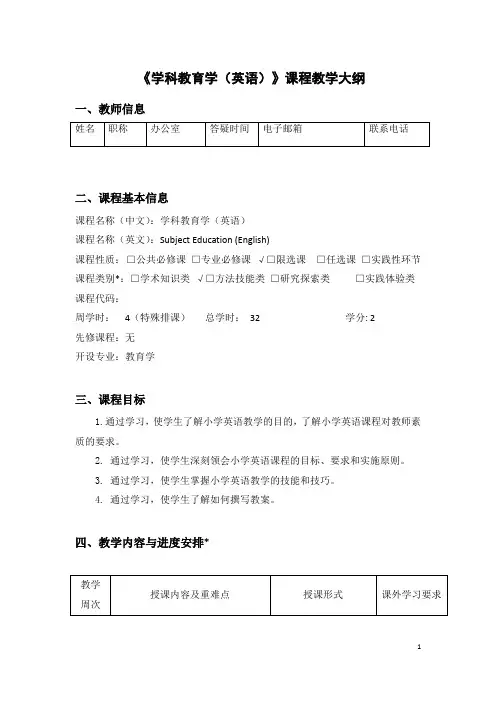
《学科教育学(英语)》课程教学大纲一、教师信息二、课程基本信息课程名称(中文):学科教育学(英语)课程名称(英文):Subject Education (English)课程性质:□公共必修课□专业必修课√□限选课□任选课□实践性环节课程类别*:□学术知识类√□方法技能类□研究探索类□实践体验类课程代码:周学时:4(特殊排课)总学时:32 学分: 2先修课程:无开设专业:教育学三、课程目标1.通过学习,使学生了解小学英语教学的目的,了解小学英语课程对教师素质的要求。
2. 通过学习,使学生深刻领会小学英语课程的目标、要求和实施原则。
3. 通过学习,使学生掌握小学英语教学的技能和技巧。
4. 通过学习,使学生了解如何撰写教案。
四、教学内容与进度安排*五、修读要求学生应在课堂授课前自学有关内容,准备好参加课堂的提问与讨论;上课积极参加讨论;课后及时、认真完成各种类型的作业,诚信自律,自主完成,一经发现有抄袭或伪造记录,本次作业以0分计。
上课不迟到早退,三次无故缺席不得参加期末考核;上课时应保持手机静音状态,除非特殊情况不得离开课堂。
六、学习评价方案课堂表现占30%。
课堂表现包括出勤率、课堂参与度和完成课堂任务等情况。
其中出勤率占10%;课堂参与度和完成课堂任务占20%。
个别展示占20%;板书10%。
期末考试占40%。
七、课程资源教材;《小学英语学科知识与拓展》,王融主编,华东师范大学出版社,2014补充阅读:《小学英语教学活动设计案例精选》,禹明主编,北京大学出版社,2012八、其他需要说明的事宜Ⅱ单章教学设计第一章Children as Language Learners 儿童作为语言初学者一、名称Children as Language Learners二、教学目标了解第一语言和第二语言的异同,了解儿童是如何学习语言的,了解在语言学习过程中儿童的个体差异,了解一名小学英语教师应具备的素养。
三、主要知识点或技能1. Learning one’s first language 学习第一语言2. Differences and similarities between learning L1 and L2 学习第一语言和第二语言的异同3. Understanding how children learn 了解儿童是如何学习的4. Individual differences in learning a language 语言学习的个体差异5. Qualities of a good primary English teacher 小学英语教师的素养四、教师教学任务使学生了解第一语言和第二语言的异同,了解儿童是如何学习语言的,了解在语言学习过程中儿童的个体差异,了解一名小学英语教师应具备的素养。
英语学科的特点英语学科的特点,主要表现在以下几个方面:1、英语学科是一门语言学科,具有广泛的实用性。
英语学科的教学目标是培养学生的英语综合应用能力,特别是听说读写能力,使他们能够在日常生活和未来工作中自如地运用英语进行口头和书面交流。
2、英语学科强调基础知识和基本技能的掌握。
学生需要掌握足够的词汇、语法、语音和听力等基础知识,同时还需要具备流利的口语表达和良好的阅读写作能力。
3、英语学科具有丰富的人文内涵。
英语承载了丰富的文化、历史、社会和人文信息,学习英语可以更好地了解西方文化和思维方式,促进跨文化交流和理解。
4、英语学科具有多样性和灵活性的特点。
英语的学习和应用不仅限于课堂和教材,还包括各种媒体、网络、社交活动等多元化的学习资源。
同时,英语学科的教学方式也具有灵活性,可以根据学生的实际情况和需要进行调整和变化。
5、英语学科需要长期的学习和实践。
英语学习需要长期的积累和实践,需要学生不断地练习和使用英语,才能达到流利、准确和自然的英语表达能力。
英语学科的特点主要表现在其实用性、基础性、人文性、多样性和长期性等方面。
为了更好地学习英语,学生需要充分了解这些特点并采取相应的学习策略和方法。
教师也需要在教学中注重这些特点,采用合适的教学方法和手段,以提高教学效果和学生英语学习水平。
英语是高中阶段的一门重要学科,它具有不同于其他学科的显著特点。
本文将就高中英语学科特点进行探讨。
一、广泛性英语是一门世界性语言,它的应用范围非常广泛。
高中英语课程涵盖了听、说、读、写四个方面,涉及到的内容包括生活、学习、工作、社交等各个领域。
因此,高中英语学科特点之一就是广泛性。
学生需要掌握的词汇量大,语法知识丰富,而且还需要具备一定的文化背景知识。
二、实践性英语是一门实践性很强的学科。
高中英语课程强调学生的语言实践,包括口语练习、听力训练、阅读理解、写作练习等。
这些实践活动可以帮助学生掌握语言技能,提高语言运用能力。
因此,高中英语学科特点之一就是实践性。
英语学科教育学随着全球化的加速和世界经济的融合,英语作为全球通用语言的重要性日益凸显。
相应地,英语教育在全球范围内都受到了极大的。
英语学科教育学作为研究英语教育规律和方法的学科,旨在提高英语学习者的语言能力、文化素养和跨文化交际能力。
本文将从英语学科教育学的定义、发展历程、主要研究内容和未来发展趋势等方面进行探讨。
英语学科教育学是教育学与语言学的交叉学科,主要研究英语教育的规律、方法和内容。
它涉及语言学、心理学、社会学和教育政策等多个领域,旨在提高英语学习者的语言技能、文化素养和跨文化交际能力。
英语学科教育学的发展与全球化进程密切相关,随着国际交流的增加和英语普及的加速,英语学科教育学在国内外教育体系中的地位也逐渐提升。
英语学科教育学的研究内容广泛而深入,主要包括以下几个方面:英语语言知识与技能:研究英语语音、词汇、语法和听说读写等语言技能的培养。
英语教育政策与课程设计:分析英语教育政策,探讨英语课程的目标、内容、教学方法和评估方式等。
跨文化交际与文化教育:研究跨文化交际能力的培养,探讨如何将文化教育融入英语教育。
英语教师教育与专业发展:研究英语教师的培养、选拔和培训等,教师的专业发展和教育教学能力的提升。
英语学习策略与评估:研究有效的英语学习策略和方法,探讨英语学习评估的标准和手段。
随着科技的发展和教育需求的变化,英语学科教育学将迎来新的发展机遇和挑战。
未来几年,英语学科教育学将呈现以下发展趋势:更加注重个性化学习:随着大数据和人工智能技术的应用,英语学科教育学将更加注重个性化学习,为每个学生提供定制化的学习资源和教学方案。
混合式学习模式的普及:结合线上和线下的教学优势,混合式学习模式将在英语学科教育学中得到广泛应用,提高教学效果和学习体验。
评估方式的多元化:除了传统的考试和测试,未来的英语学科教育学将更加注重过程性评估、表现性评估和自我评估等方式,全面了解学生的学习情况和进步。
教师教育的数字化转型:随着教师教育资源的数字化,未来的英语学科教育学将更加注重教师教育的数字化转型,提高教师教育的质量和效率。
英语教育学知识点归纳英语教育学是研究英语教育的一门学科,旨在提高英语教学和学习的效果。
它涵盖了从教学到学习的各个方面,包括教育原理、教学方法、教材设计等内容。
下面将对英语教育学的一些重要知识点进行详细介绍。
一、教学原理1. 学习理论:学习理论是英语教育学的基础,包括行为主义学习理论、认知学习理论和社会文化学习理论等。
行为主义理论认为学习是通过和反应来实现的,认知学习理论强调学生自主构建知识,而社会文化学习理论关注学习环境和社会互动的影响。
2. 教学目标与评价:教学目标是指教师希望学生在学习过程中达到的预期结果。
评价是对学生学习成果进行检验和评估的过程。
教学目标与评价需要具体、可测量、可达到,并且要与学生的实际水平相适应。
3. 教学方式与方法:教学方式是指教师在教学中所采用的基本态度和行为方式,包括讲授、讨论、合作学习等;教学方法是指教师在实际教学中采用的具体策略和技巧,如演示法、游戏法、情景教学法等。
二、教材与教学设计1. 教材选择与评价:教材是教学的核心资源,对于英语教育学来说尤为重要。
教师需要根据教学目标、学生需求和教育政策等因素选择合适的教材,并对教材进行评价,以确保教学内容的准确性和有效性。
2. 课堂教学设计:课堂教学设计是指教师在具体的教学过程中安排和组织学习活动的过程。
良好的教学设计应该充分考虑学生的学习特点和需求,合理选择教学方法和教学资源,并注重培养学生的学习能力和素质。
3. 多媒体教学:多媒体教学是指利用电脑、投影仪、音频、视频等多种媒体技术进行教学。
它具有形象直观、生动活泼等特点,可以激发学生的学习兴趣和积极参与。
三、语言技能与教学1. 听力教学:听力是英语学习中的重要技能,教师需要通过一系列听力活动帮助学生提高听力理解能力。
这包括选择合适的听力材料、设计多样化的听力任务以及培养学生的听力策略等。
2. 口语教学:口语是英语交流的基本技能,教师应该通过情景模拟、角色扮演等方式训练学生的口语表达能力。
英语学科教育学复习资料英语学科教育学复习资料英语学科教育学是培养英语教师的重要学科之一,它涉及到教育学的理论与实践在英语教学中的应用。
在学习英语学科教育学时,我们需要掌握一些复习资料,以便更好地理解和应用这门学科的知识。
本文将为大家介绍一些英语学科教育学的复习资料,帮助大家更好地备考。
一、教育学基础知识在学习英语学科教育学之前,我们需要先掌握一些教育学的基础知识。
这些知识包括教育学的定义、教育学的发展历程、教育学的主要理论流派等。
我们可以通过阅读教育学教材或参考书籍来学习这些基础知识。
此外,还可以通过参加教育学相关的讲座、研讨会等活动来深入了解教育学的最新研究动态。
二、英语教学理论英语学科教育学的核心内容是英语教学理论。
在学习英语教学理论时,我们需要掌握一些重要的理论框架和概念,如语言习得理论、教学法、评估与测试等。
我们可以通过阅读相关教材和学术论文来学习这些理论知识。
此外,还可以通过观摩优秀教师的课堂教学来了解这些理论在实际教学中的应用。
三、教材与教学设计在英语学科教育学中,教材与教学设计是非常重要的内容。
我们需要了解教材的编写原则、教材的评价标准以及如何根据学生的需求和能力设计有效的教学活动。
我们可以通过阅读教材编写的相关书籍和教材评价的研究论文来学习这些知识。
此外,还可以通过参加教材编写和教学设计的培训课程来提高自己的能力。
四、教育技术与多媒体教学随着科技的发展,教育技术在英语教学中的应用越来越重要。
我们需要了解教育技术的发展趋势、教育技术的应用原则以及如何使用多媒体教学工具来提高教学效果。
我们可以通过阅读教育技术的相关书籍和学术论文来学习这些知识。
此外,还可以通过参加教育技术培训课程和实践活动来提高自己的教育技术能力。
五、教育研究方法在英语学科教育学中,教育研究方法是非常重要的。
我们需要了解教育研究的基本原理、常用的研究方法以及如何设计和实施教育研究。
我们可以通过阅读教育研究方法的相关书籍和学术论文来学习这些知识。
课时:2课时年级:大一教学目标:1. 学生能够理解大学英语教育学的概念、发展历程和基本理论。
2. 学生能够掌握大学英语教育学的教学方法和技巧。
3. 学生能够运用所学知识分析和解决实际教学问题。
教学重点:1. 大学英语教育学的概念和基本理论。
2. 大学英语教育学的教学方法和技巧。
教学难点:1. 大学英语教育学的教学方法和技巧在实际教学中的应用。
教学准备:1. 教师准备PPT、相关教学案例和讨论问题。
2. 学生预习大学英语教育学的相关内容。
教学过程:第一课时一、导入1. 教师简要介绍大学英语教育学的概念和发展历程。
2. 引导学生思考大学英语教育学的意义。
二、教学内容1. 大学英语教育学的概念和基本理论- 解释大学英语教育学的定义和内涵- 分析大学英语教育学的理论基础2. 大学英语教育学的教学方法和技巧- 讲解交际教学法、任务型教学法等常见教学方法- 介绍教学技巧,如提问技巧、课堂管理技巧等三、案例分析1. 教师展示一个大学英语教学案例,引导学生分析案例中的教学方法和技巧。
2. 学生分组讨论,分享自己的观点和看法。
四、课堂讨论1. 教师提出与大学英语教育学相关的问题,引导学生进行讨论。
2. 学生积极发言,表达自己的观点。
第二课时一、复习导入1. 教师回顾上节课的学习内容,检查学生对大学英语教育学的理解。
2. 引导学生思考如何将所学知识应用于实际教学。
二、教学内容1. 大学英语教育学的教学方法和技巧在实际教学中的应用- 以具体教学场景为例,讲解交际教学法、任务型教学法等在实际教学中的应用- 分析教学技巧在课堂管理、学生互动等方面的作用2. 学生分组进行角色扮演,模拟实际教学场景,运用所学知识进行教学。
三、总结与反思1. 教师总结本节课的学习内容,强调大学英语教育学的教学方法和技巧的重要性。
2. 学生分享自己的学习心得,反思自己在实际教学中的应用。
教学评价:1. 学生对大学英语教育学的概念、发展历程和基本理论的理解程度。
大学英语的学科教育学视野[摘要]以学科教育学的视野研究大学英语学科教育,探讨确定科学、全面的大学英语学科教育目标,进而研究目标的实施、实现与检测评估,有利于解决当前在此领域存在的一些亟待解决的重点问题,促进大学英语学科教育乃至整体学科教育、学校教育和高等教育目标的实现和质量的提升。
[关键词]大学英语学科教育理论视野学科教育学学科教育学,是一门新兴的以学科教育为研究对象的教育科学,包括具体学科教育学和整体学科教育学。
首先,学科教育学要明确学科教育的目标;其次,要研究学科划分,以及各学科之间、学科与非学科之间的关系;再次,是研究更具体层次的课程、教学、学习、评价等。
相对于学科课程与教学论来说,学科教育学领域更广、层次更多、水平更高。
以学科教育学的视野研究大学英语学科教育,建构大学英语学科教育学,探讨大学英语学科教育如何在服从和服务于整体学科教育目标和高等学校的总体教育目标的基础上,确定具体的学科教育目标,进而研究目标的实施实现与检测评估,这是非常有意义的。
一、学科教育学概述1.学校教育、学科教育、非学科教育学校教育的实施途径包括学科教育与非学科教育两种。
(学科有两层不同的含义:一是学术学科,指人类知识体系中的门类,其英文称谓为discipline或academic discipline;一是学校学科,指学校教育中主要教育内容的门类,其英文称谓为subject或school subject。
本文所论的学科,是指学校学科。
)其中,学科教育是主要途径。
两者之间互相联系,一定程度上可以互相转化。
对于学科教育的研究大致经历了三个阶段:一是学科教材教法阶段;二是学科课程与教学论阶段;三是学科教育学阶段。
每一阶段大致都经历了从对具体学科的研究到对整体学科的研究两个过程。
2.学科教育学学科教育学在我国萌芽于20世纪末期,初步形成于21世纪初期,现在正处于基本形成与发展深化的阶段。
学科教育学,概括地说,是以学校教育中的学科教育为研究对象的一门教育科学;具体地说,是以全面实现教育目的为目标、以相关学科研究成果为理论支撑的研究学科教育目标、学科、课程、教学、学习、评价等全过程及其内在规律以及学科教育与非学科教育关系的一门教育科学。